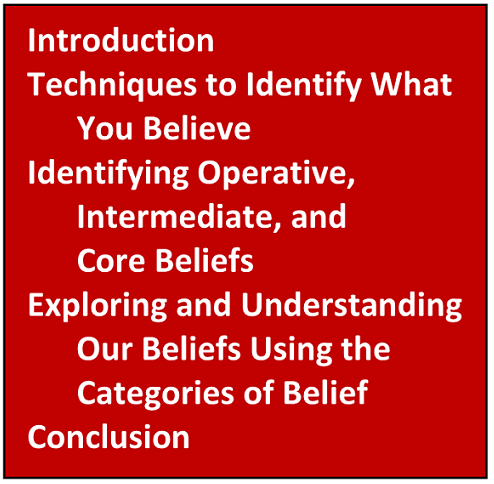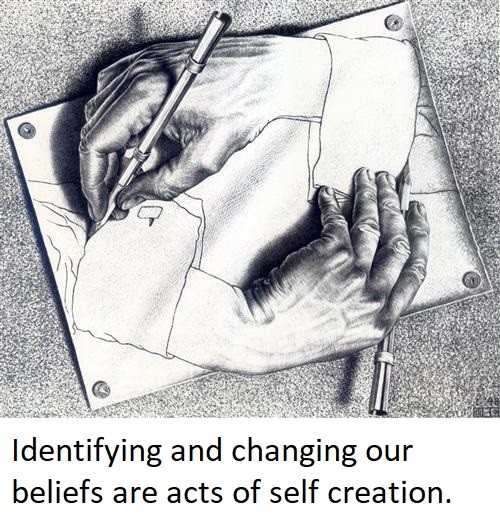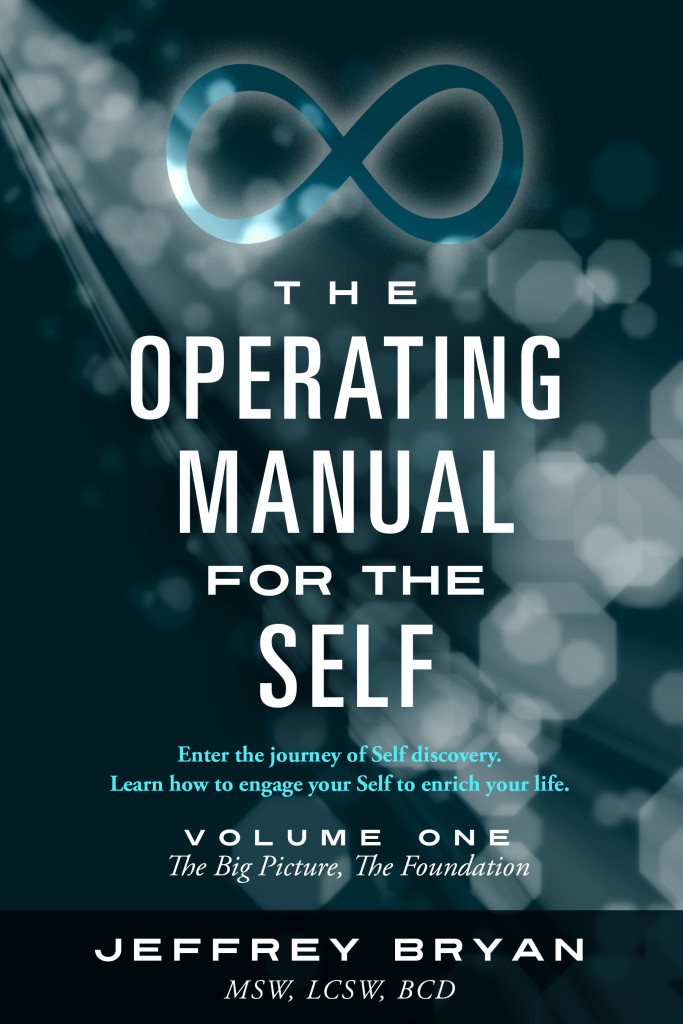Beliefs (Part III): Identifying Beliefs Pdf
INTRODUCTION
Working with our beliefs can be challenging but extremely rewarding. This newsletter is challenging so please take your time reading it.
We define beliefs as thoughts held over time that: describe the way we and the world work; describe our view of ourselves; and are the fundamental ideas that guide our actions in the world. We don’t really know what our beliefs are. As we live our lives, we take them for granted. They operate in the background of our awareness influencing our thinking, feeling, and actions. Our beliefs give rise to the thoughts we think. Our thoughts give rise to the feelings we experience. Beliefs motivate the actions we take that create our lives. To change your life, determine what your motivations are. To change your motivations, know what your beliefs are and change them. Let’s explore how we can discover what our beliefs are. We will then be able to recognize and reinforce the beliefs that work for us and identify the beliefs that create aspects of our life that we are unhappy about. In the next Letter (June) we will explore how to change the beliefs that are not creating the life we want and how to identify and adopt expansive beliefs.
TECHNIQUES TO IDENTIFY WHAT YOU BELIEVE
Here are some techniques to discover what your beliefs are and examples of how to use them.
Pick a topic and write down your ideas about that topic. Before each sentence write: “I believe that. . .”  Allow your mind to express itself without any censorship.
Allow your mind to express itself without any censorship.
- I believe that marriage is valuable, but sometimes causes a lot of pain. I believe that marriage as a symbol of commitment is important. I believe that marriage is unnecessary because people can make a commitment to their relationship without betting married. I believe that the legal aspects of marriage create problems. I believe that the laws about marriage and divorce are unnecessary. I believe that government should not regulate marriage.
Pick a topic, write the words “me and…” Free associate by writing down every thought you have about that topic, without any censorship. Sort through what you have written down to identify which thoughts are beliefs.
- Me and my car: I love my car. I hate my car. My car is very important to me. My car gives me independence. I hate when my car breaks down. I feel admired when someone admires my car. My car cost me $40,000. I paid for it in installments over five years. I bring it for a tune up every three months. I get it washed every week.
The first six sentences are beliefs. The last four sentences, starting with—My car cost me $40,000, are “statements of fact.”
Examine an event in your life. Identify the actions that you took to create that event. Ask yourself, “What must I believe to act in this way?” Relax and allow ideas to come to you, write them down. This exercise is extremely powerful as it shows us how our beliefs create our life and helps us identify the beliefs we need to change to change our life.
- I graduated college. To accomplish this, I took the following actions. I went to college for four years. I studied and passed exams. I read books and articles. I wrote papers. I went to class. I paid the college tuition. The beliefs that created the motivation for these actions are: going to and graduating college is worthwhile and important. College graduates earn more money during their lifetime than non-college graduates. Learning and gaining knowledge enhances your life. Going to college is a great way to spend the years in between graduating high school and entering the workforce. Going to college is a good transition between adolescence and adulthood. Going to college is fun.
Start with a painful feeling like frustration, disappointment, anger, sadness, or anxiety. Describe the feelings and a context (situation) where they arise. Trace the feeling to the thoughts that generate it, and then to the beliefs that generate the thought.
- I feel frustrated and angry because my friend cancelled our date to go out. Feelings/thoughts: I feel frustrated at not getting something I wanted. I don’t like feeling frustrated. I feel angry about feeling frustrated. I feel angry at my friend for “causing” me to feel frustrated. Beliefs: when I don’t get my way I am right to feel frustrated. I don’t like frustration. Frustration is painful. I am right in blaming my friend for “making” me frustrated and angry. I have the right to blame anyone for anything. My feelings are caused by the behavior of other people. My feelings are painful and are dangerous.
Choose a period of time. Write down all the thoughts that occurred during that period of time and write “I believe that. . . ” before each thought, including “facts. Then eliminate the thoughts that are not beliefs. This exercise sharpens our ability to distinguish beliefs from other kinds of thoughts. It begins to create the understanding that most of what we think is based on beliefs.
- I believe that there is a movie I want to see—fact. I believe that the movie I want to see is worthwhile—belief. I believe that I will go to the movies today—belief. I believe that I will need to leave the house 45 minutes before the movie starts—belief. I believe that I will invite a friend to go with me—planned action. I belief that I will have more fun going with a friend than by going by myself—belief. I believe that I am going to have a good time enjoying the movie and my friend’s company—belief.
This example illustrates the prevalence of beliefs in our thinking. If we see that there are so many beliefs in our thinking and can see the possibility that we could hold alternative beliefs, we can see possibilities for change.
With these techniques we can become proficient at identifying our beliefs and therefore gaining more control over our everyday experiences.
Point of Empowerment: Knowing the characteristics of beliefs will help us change our beliefs. This will make changing beliefs easier because changing beliefs often involves finding a new belief to substitute for an old one. Knowing the characteristics of the belief helps us create a new belief.
Let’s explore the characteristics of belief in the next two sections.
IDENTIFYING OPERATIVE, INTERMEDIATE, AND CORE BELIEFS
In the April Letter we defined the levels of belief: operative, intermediate, and core beliefs. How can we determine which of our beliefs are operative, intermediate, and core? Let’s look at an example first, then we will describe a procedure.
- Situation: I obtained a new job. Actions: I decided I wanted a new job. I consulted various sources—online, networking, and newspaper ads, to see what was available. I sent out resumes. I went on job interviews. I received offers and chose one of them. Operative belief: certain actions will result in accomplishing my goal. Intermediate beliefs: I have something of value to offer a new employer. Core belief: I can get what I want if I take effective action. I offer what I have of value to the world and the world often gives me something of value in return.
To identify beliefs and to distinguish among operative, intermediate, and core beliefs, we start with a situation. Determine what you did (what actions you took) to create the situation. To discover operative beliefs, explain why you took these actions. To discover intermediate beliefs, explore more about you personally with respect to the specifics of the situation. To determine core beliefs, explore more about you personally with respect to who you are as a person, keeping in mind the situation as a specific context. Remember, core beliefs are generally global, generalize statements of belief about yourself.
If we want to start with a belief, we can write down the belief, find a situation where this belief operates and go through the procedure we just described. For example:
- Belief: I am not good enough. Situation: my 9-year-old son is yelling at me telling me how he never gets what he wants from me. Action: I become defensive and tell him why he is wrong. I feel not good enough. (Here we are viewing feeling as an action.) Operative belief: I won’t let my child yell at me in an accusing way. I need to set him straight. Intermediate belief: I don’t give him what he needs and therefore I am not good enough as a mother. I have failed. Core belief: I am not good enough as a person and nothing I do will ever convince me that I am good enough.
EXPLORING AND UNDERSTANDING OUR BELIEFS USING THE CATEGORIES OF BELIEF
Point of Empowerment: Improving our life is changing our beliefs. The process for this begins with identifying the belief, then exploring and understanding the belief, and then using techniques to change the belief.
We have identified the belief and considered if it is operative, intermediate, or core. We can also classify the belief according to the categories of belief. To categorize a belief, apply the definitions. (Please see the Letter for March for the definitions of the categories of belief and for examples. https://iifsd.org/library/newsletters/march-2018-letter/ )
Understanding the level and categories of belief will make changing beliefs easier. Knowing that the old belief is operative, intermediate, or core helps us generate a new belief at the same level. Knowing that the old belief is: an opinion, about the nature of reality, about ourselves, a value, a possibility, or an explanation of cause and effect helps us generate a new belief in the same category.
The chart below can guide us in this process.
(You may be interested in the Letters about values, April, May, and June 2017.)
CONCLUSION
We have learned how to identify beliefs and how to explore and understand them. Our beliefs range from simple to very complex. This reflects the nature of the parts of ourselves that generate and carry the belief, simple to very complex. Next month (June) we will learn how to change beliefs.

